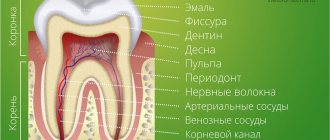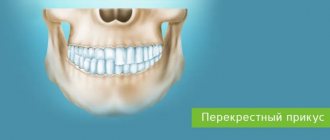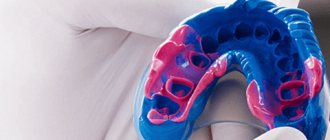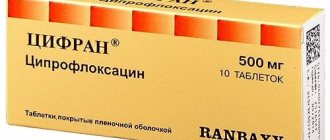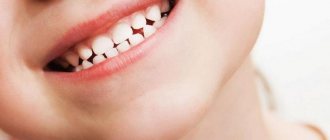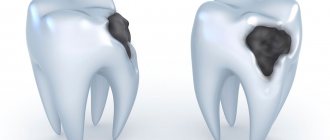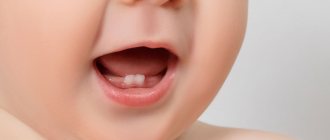Milk and molar teeth in children
Many people believe that there are no differences between permanent and temporary teeth, but this is not true. So, how to distinguish a baby tooth from a molar? At a minimum, their number differs (milk - 20, permanent, as a rule, 32). Temporary teeth have a light shade, while permanent teeth are naturally more yellow. Indigenous ones are also significantly larger in size than dairy ones - visually it is quite easy to distinguish them. Here are the most common questions asked by Internet users on this topic.
- Do children have molars?
Of course, there are, and at a certain point they begin to actively erupt. - How many molars do children have?
From 28 to 32 (the maximum set appears after all eights appear). - Which molars appear first in a child?
Typically, the lower central incisor erupts first. - At what age do children start to get their molars?
Usually, dentition renewal begins after 6–7 years, but there are no strict limits. - Do children lose molars?
By themselves - no, as a result of injuries and illnesses - yes. - What are the risks of removing a molar tooth in children?
As corny as it may sound, his loss. And yes, a new one will not grow. Everything is like adults. - What to do if a child has yellow molars?
Permanent teeth have a more yellowish tint than temporary teeth. Plaque on a child’s molars is normal, but hygiene should never be neglected. - What to do if a child has black molars?
When teething, baby teeth may have a black color (the so-called Priestley plaque, or pigment bacteria). However, this does not happen with molars. If they are black, go to the dentist immediately. - What to do if a child does not have molar buds?
This happens, but very rarely. Fortunately, with modern implantation and prosthetics technologies, the problem can be solved. - Is it normal for a child to have crooked molars?
Contact an orthodontist immediately: correcting a bite in childhood is much easier and faster than in adults. - Which teeth do children replace with molars?
All twenty, plus new molars appearing.
Removing or retaining wisdom teeth
Even before the “eight” stage, you can discuss with your doctor how many of your 4 wisdom teeth to keep and how many to remove. Dentists believe that it is necessary to preserve third molars when:
- no signs of crowded teeth;
- the crowns of wisdom teeth are positioned vertically;
- first and second molars are missing.
Factors such as the lack of free space on the jaw play in favor of removing “eights”: the existing teeth are tightly spaced, there are no plans to remove the molars, their condition is good or excellent.
Other indications for removal:
- incorrect position of the tooth crown - horizontal or inclined, creating pressure on the roots and crown of the adjacent molar;
- prolonged lack of progress in teething in the presence of intense symptoms;
- repeated inflammation and suppuration in the eruption area;
- caries of the crown of the third molar.
They can be removed both before and after eruption. This procedure is painless and does not take much time. The procedure is performed under local anesthesia. Some clinics use sedation to make the procedure as comfortable as possible for the patient.
Molars in children: symptoms of eruption
- Fever. When teething in children, body temperature may rise, usually not higher than 38 degrees.
- Itching and pain at the site where the molar appears. Various gels and ointments, as well as gum massage, will help relieve children from unpleasant sensations.
- Increased salivation and runny nose.
Important!
The growth of molars in children, especially at the initial stage, leads to weakened immunity. Take vitamins and do not forget about preventive visits to the dentist.
First signs
It is advisable to recognize the onset of teething in a child in time in order to be able to provide him with the necessary help. As a rule, symptoms of the upcoming appearance of the first tooth in a baby appear within a few days - in most children this period lasts up to several days and ends with the eruption of the outer shell of the gums.
Parents can recognize that their baby is starting to teethe by the following signs:
- The appearance of sudden changes in the child’s behavior: sleep disturbance, irritability, crying, refusal to take the breast or pacifier;
- The formation of increased salivation, often accompanied by the appearance of rashes around the baby’s mouth, chin, and chest due to excessive saliva;
- At the site of tooth eruption, the gums swell and become swollen;
- The child bites everything that gets into his hands, trying to relieve the irritating itching that appears in the gums.
When does a child's molars come out?
Most parents are interested in the question: at what age do children’s molars begin to erupt? The first buds form in the fifth month of pregnancy. The exact timing of their appearance has not been determined and depends on the individual characteristics of the organism. Nevertheless, an approximate scheme for the eruption of molars in children exists. If the appearance of a permanent tooth is delayed for more than six months from the extreme threshold (especially after the loss of a baby tooth), consult a specialist. The doctor will take control of the process and be able to identify complications.
How to help your baby when he is teething
Teeth are breaking through - it even sounds painful. Indeed, when a baby starts teething, it is often painful. Many children sleep poorly, often cry, and some even develop a fever. But there are other symptoms that indicate your baby is going through the baby teething period. The first signs of teething and, above all, what to do when teeth appear and how to reduce pain will be discussed in a conversation with first category pediatrician Ekaterina Borisovna Bulavina.
— Ekaterina Borisovna, please tell us when do babies usually start teething?
— The timing of teething varies quite widely. On average, the first teeth emerge at 5-7 months, but the process can begin earlier (at two or four months) or take up to a year. And some babies are born with teeth. Everything is very individual and depends on many factors, such as heredity, sufficient calcium intake in the body, the gender of the child, and the climate in the place of residence.
— How quickly will teeth be cut after the first one appears?
— In both boys and girls, the process of complete eruption of the primary dentition usually takes 2.5–3 years. The upper incisors appear 2-3 months after the appearance of the lower ones, then at the age of 9-13 months the upper and lower lateral incisors erupt. From one year to one and a half years, the upper and lower first molars alternately appear, then, by 20 months, the upper and lower canines, and by 2-2.5 years, the second molars. However, the order and timing when babies start teething are very arbitrary.
Table and chart by month: what time do children start teething?
How can you tell if your baby is teething?
— The appearance of teeth, although physiological, is a real test for the child and his mother and father. Only recently have we experienced colic, a feeding and sleeping schedule has been established, when suddenly the baby becomes restless again, is capricious, refuses to eat, or, on the contrary, often and greedily grabs the breast or bottle, sleeps poorly and puts everything in his mouth. These are sure signs that teething has begun.
Some lucky people endure the entire process completely painlessly, and only a casual tap on the gum with a spoon reveals the first tooth that has already erupted. But sometimes the moment of teething is so difficult for the baby that it is easy to confuse it with the onset of the disease.
Only a doctor can determine the real cause of the child’s anxiety, and you should definitely contact him if the temperature rises to febrile levels, severe lethargy, weakness or, conversely, severe excitability of the baby, as well as if signs of infection occur, such as a runny nose, cough, frustration digestion, vomiting, loose stools.
— Ekaterina Borisovna, parents are waiting for the appearance of the first incisors with caution. What symptoms characterize the process besides pain?
— When teeth are cut, the symptoms are very diverse, and everything is individual. In this case, the symptoms may differ depending on the location of the cutting teeth. Usually the most unpleasant sensations accompany the appearance of only the first teeth. All subsequent ones erupt more calmly, and the child practically stops paying attention to this process. When chewing teeth appear, pain may resume, but it is not as intense as at the very beginning of eruption. The appearance of the upper teeth is often accompanied by a runny nose: this is due to the proximity of the location and the single network of blood supply to the upper jaw and nasal cavity.
| First symptoms of teething | Features of the child’s condition and behavior |
| Swelling and redness of the gums |
|
| Excessive salivation |
|
| Decreased appetite or complete refusal to eat |
|
| Increased moodiness |
|
| Temperature |
|
| First symptoms of teething : Swelling and redness of the gums | Features of the child’s condition and behavior
|
| First symptoms of teething Excessive salivation | Features of the child’s condition and behavior
|
| First symptoms of teething Decreased appetite or complete refusal to eat | Features of the child’s condition and behavior
|
| First symptoms of teething Increased moodiness | Features of the child’s condition and behavior
|
| First symptoms of teething Temperature | Features of the child’s condition and behavior
|
— When is it better to lower the temperature during teething?
— Typically, antipyretic therapy is prescribed when the temperature rises above 38.5 degrees. Low-grade fever, up to 38 degrees, should always be brought down in children with organic damage to the central nervous system, with the threat of seizures, as well as with pronounced changes in the general condition of the child.
— Why do you need to carefully monitor your baby’s health during teething? Does teething affect the immune system?
— Teething is a rather complex process in which all systems of the child’s body are involved. The immune system is no exception. When the tooth moves, traumatic damage to the gums occurs and, as a result, inflammation occurs in the tissues. Immune cells rush to the inflammatory focus, trying to eliminate it, which somewhat weakens the local protective reaction. In addition, in abundantly secreted saliva, the content of the enzyme lysozyme is reduced, and it loses its protective properties. In addition, during this period the child puts everything into his mouth, trying to scratch the itchy gums, which increases the risk of infection and injury to the mucous membrane.
— How can parents distinguish teething from other problems, such as a cold?
— It is sometimes difficult even for a specialist to distinguish a viral infection from teething syndrome: very often the two conditions occur simultaneously. With eruption syndrome, the temperature rarely exceeds 38-38.5 degrees, the discharge from the nose is copious, mucous in nature, often transparent. The cough is superficial and occurs more often in a horizontal position. All symptoms are accompanied by profuse salivation. The child's general condition rarely deteriorates; the child is capricious, whiny, but not lethargic or apathetic.
Teething can also be accompanied by symptoms of dyspepsia, such as regurgitation, and sometimes even vomiting, and loose stools. Unlike an intestinal infection, regurgitation and vomiting are episodic and occur when there is an excessive accumulation of saliva.
Liquefied stools may be associated with increased motility due to an increase in temperature - swallowing large amounts of saliva and intense chewing movements. Stool 1-2 times a day, normal color and smell, without pathological impurities, but softer consistency.
If any symptoms appear that do not fit into the picture of teething, you should definitely consult a doctor.
— Does all children experience pain during teething?
— Each child has his own pain sensitivity threshold. The intensity of inflammatory reactions is also different for everyone, so each baby experiences teething differently. If one continuously cries all night, the other may behave in a completely normal way. It depends both on genetics and on the baby’s temperament.
— When teeth are being cut, how can you help your baby? What medications are allowed to be given to relieve pain?
— Pain-relieving gels are widely used. However, you should remember the rules for their use. They have a short-term effect, about 20-30 minutes, but it is not recommended to use them more than five times a day. The gel is applied in a thin layer to avoid an overdose of the drug. And, as is the case with any medicine, do not forget about a possible allergic reaction in the baby.
You can quickly and permanently relieve pain only with anti-inflammatory drugs. And there are a lot of BUTs here. Any drug is unsafe, especially if given for the first time. Only a doctor can assess the child’s condition and prescribe anti-inflammatory therapy if necessary, taking into account the risk-benefit ratio.
Medicines from the group of non-steroidal anti-inflammatory drugs can be prescribed internally. The dosage is calculated by the doctor depending on the weight of the child. Gels with local anesthetic and antiseptic effects are used on the mucous membrane.
— Is it possible to relieve pain and other symptoms with folk remedies?
— Treatment with folk remedies is very popular in our country, although the global scientific community questions its effectiveness. Only exposure to cold has proven effectiveness, so it is recommended to give your child chilled pacifiers and teethers to chew on. Cold causes vasospasm, reduces swelling and inflammation in the gums, and, as a result, pain temporarily subsides. The effect is short-lived, but it still exists. Massaging the gums with a fingertip or soft brush is also helpful.
— Ekaterina Borisovna, tell us in more detail how pacifiers or toys that can be chewed help with toothache, and how to choose a pacifier and a special teether for a child.
— Gum massage helps the baby cope with unpleasant sensations. During the massage, itching decreases, gum tissue softens, and it is easier for the tooth to make its way. But constantly massaging a child’s gums is a very tedious task. He may well engage in self-massage, especially since during this period he himself happily puts everything into his mouth.
Special pacifiers or teethers will be excellent massage assistants. They differ from regular pacifiers in their greater rigidity and textured surface, and are made of latex or silicone. Many models of teethers are equipped with a cooling function - there is a liquid inside that can be cooled. Teethers are also made from plastic, wood or even textiles. But, in my opinion, they do not meet safety standards. It’s worth choosing brands that have been widely represented on the children’s goods market for a long time.
— What techniques can be used to distract a child from toothache?
- In this case, there is only one method - to surround the baby with care and attention as much as possible, pick him up more often, put him to the chest if the child asks. Next to the parents, the baby feels safe and calms down. Children react very sensitively to the behavior and emotions of adults, so it is important for parents to be calm and friendly, to distract the kids with a toy, song, or kind words. You can play finger games with older children. Relaxing massages and long walks are helpful.
Unfortunately, there are no absolutely effective methods. Parents can only help the child cope with the problem that has arisen. But there are some tips that will help you survive this difficult period.
— Please share them with our readers.
— The rudiments of teeth are formed long before birth. Therefore, during pregnancy, mothers should carefully monitor their diet. A sufficient supply of calcium is especially important for the formation of healthy teeth in a baby. But even after birth you shouldn’t forget about calcium. When breastfeeding, the mother's diet should include dairy products or calcium supplements in case the baby is intolerant to cow's milk proteins.
Hardening from birth is the key to good immunity. There is no need to wrap your child in a hundred clothes and be afraid to ventilate the rooms. Walk in any weather and for a long time, use a light contrast shower. And then the baby won’t be afraid of any cold.
Also, avoid public places, especially during the teething period. The baby is very vulnerable at this moment. Postpone visits from relatives, shopping trips and visits to closed playgrounds for a while - thereby you will reduce the risk of infection for your child.
It is also especially important to maintain optimal temperature conditions in the room during this period. Heat and dry air will only increase discomfort.
Teething is a difficult stage in a child’s life. If the process causes severe discomfort, is accompanied by the appearance of alarming symptoms, or high fever, then you should contact a specialist for help as soon as possible. Otherwise, surround your baby with care and attention, select pacifiers, teethers, toys that relieve itching, and use medications with the doctor’s permission. The main thing during this period is to be there and help the baby cope with the pain in every possible way.
Pediatrician Ekaterina Borisovna Bulavina
*The ideal food for an infant is mother's milk. WHO recommends exclusive breastfeeding for the first 6 months. MAMAKO® supports this recommendation. Before introducing new foods into your baby’s diet, consult a specialist.
Pattern of growth of molars in children
In most cases, the permanent tooth appears 3 to 5 months after the temporary tooth falls out. The order of eruption of molars is in many ways similar to the appearance of milk teeth. The first molars in children are the central lower incisors. The upper permanent teeth develop later than the lower ones, if we consider them in pairs.
| Age | Eruption of molars in children |
2 years | There have been references in history where a child was born with one or more molars. Cases when molars erupted in a 2-3 year old child also occur, but are extremely rare (less than 1%). |
5 years | When a child is 5 years old, molars very rarely come out (less than 10% of the total). If a baby tooth falls out on its own at such an early age, then there is every reason to believe that a permanent one will soon appear in its place. |
6 years | The roots of baby teeth (especially the upper and lower incisors) begin to dissolve and the teeth fall out. Usually, it is at the age of 6 that a child’s first molar begins to erupt. |
7 years | At this age, the first lower molars in children (at least one of them) have already erupted and the incisors of the upper jaw are next in line. |
9 years | At the age of 9, a child’s second molar should definitely have time to appear. Some children acquire lateral incisors and even a premolar on one of the jaws. |
10 years | At the age of ten, children’s back molars begin to actively erupt (premolars, and a little later – molars and canines). |
13 years | At 12–13 years of age, children usually develop a full bite of permanent teeth. The last teeth to emerge are usually the upper canines and second molars. This does not apply to wisdom teeth, which appear in adulthood (after 17–18 years) or may not erupt at all. |
Features of molars
Large molars differ from other groups not only in external characteristics, but also have other features :
- these are the largest units in each dental arch;
- have the largest chewing surface;
- have a powerful root system;
- the upper molars are slightly larger than those on the lower jaw;
- have a stronger surface coating;
- able to withstand weight up to 75 kg;
- upper molars have 4-6 canals, while lower units generally have only 3 canals;
- maxillary molars have 3 roots (palatal, buccal-medial, buccal-distal), less often 4;
- the chewing teeth of the lower jaw have only 2 roots;
- wisdom teeth are the very last molars, which may appear by the age of 50 or not appear at all;
- the last molars are very often located not in the chewing arch, that is, they can grow horizontally or with a slight slope, located buccally or towards the tongue or palate;
- wisdom teeth have from 1 to 5 chewing cusps;
- the last molars often have a complex root configuration (curvature, fusion).
All this entails the peculiarities of treatment of such teeth. The presence of a large number of complex root canals, as well as difficult access compared to other groups of teeth, requires highly qualified doctors and modern equipment for high-quality therapy.
In dental practice, molars are considered the heaviest units, especially wisdom teeth. Proper care and regular preventive examinations will help keep them healthy. When the first signs of damage to the molars appear, we recommend that you immediately sign up for a consultation at our KAS+ dentistry. Timely detection of dental problems guarantees their high-quality treatment with minimal risk and long service life.
Complications during teething
- Delay in the appearance of permanent teeth.
This may be due to genetic characteristics, immune system problems and a number of other diseases. - Uneven teeth and other malocclusions.
- Hyperdentia.
The child’s molar tooth (or teeth) grows in the second row. Hyperdentia, or supernumerary of teeth, is a fairly rare phenomenon, but requires the intervention of a dentist to eliminate the risk of malocclusion in a child.
Difference between molars and premolars
The main difference between molar teeth and premolars is their location on the jaw.
Premolars are located closer to the front of the dentition, and molars are slightly moved inward. Their quantity also varies. There are always two premolars on each side of the upper and lower jaws. There can be either two or three molars. Still others are also called “wisdom teeth.” They grow later than others and often appear only at 20-25 years of age. This process is often accompanied by malaise and fever. However, not all people on earth have third ones. A certain genetic predisposition can cause the absence of wisdom teeth in the oral cavity.
Common problems with molars in children
| Problems with molars | How to fix? |
| Molar tooth is loose | A common occurrence with injuries and bruises. To avoid tooth loss, an urgent visit to the dentist and the application of a special splint are necessary, especially if the child’s molar sways when touched. |
| Broken molar tooth | Severe chips may require orthopedic treatment. If a child's front molar has chipped, aesthetic restoration with veneers or crowns may be required. |
| Molar caries | When the first molars erupt, it is important to prevent the occurrence of caries. If this happens, then it is necessary to stop the disease in its infancy, otherwise it will affect the deeper layers of the tooth. |
| A child's molar has fallen out | The most unpleasant thing that can happen. If a child knocks out a molar along with the root, then there is a chance to save it. To do this, you need to place the knocked out tooth back into the oral cavity, saline solution or into a glass of milk and urgently rush to the dentist (you need to do it within 30 - 40 minutes after the injury). If a child’s molar tooth has been removed, then there is only one way out - installing a prosthesis. |
Which teeth appear first?
If the timing of the appearance of baby teeth in all children is quite individual, then the order of eruption is always the same (except in rare cases). The first to appear in the dentition are the incisors - the frontal teeth, located in the center of the jaw arch and having an elongated shape with a sharp surface intended for biting off food. The lower incisors usually appear first - they are slightly smaller than the teeth located in the upper dentition, but perform the same functions and have the same structure.
First central incisors - photo
Table No. 1. Scheme of eruption of incisors in a baby.
| Teeth position | Appearance date |
| Lower anterior incisors | 4-8 months |
| Upper frontal incisors | 6-9 months |
| Lateral lower incisors | 9-12 months |
| Upper lateral incisors | 10-16 months |
Note! During the first year of life, a child should normally erupt 8 teeth - 4 incisors on each jaw. It is possible that a child at this age has 7 teeth or even 2-4 teeth. Such a clinical picture can be considered normal if the child does not have chronic diseases of the endocrine system and other pathologies characterized by slowing or disruption of metabolic processes. If a one-year-old child has missing teeth, you should undergo an examination - this may be a symptom of rickets or a manifestation of adentia.
Baby is cutting teeth
Care instructions
Molars in children require even more careful care than in adults. Frail enamel is much more susceptible to the effects of carious bacteria and the external environment, and the love of sweets and carbonated drinks does not add strength to it. When children develop a permanent bite, parents need to take special control of oral hygiene and diet (at least until the age of 14–15, when the teenager himself begins to realize the importance of dental health). In general, there are no difficulties here: in order to keep children's teeth strong and healthy, you need to follow several basic points.
- Daily hygiene.
Brush your teeth at least twice a day, use dental floss and special rinses. - Proper diet.
Limit your intake of sweets and carbohydrates. - Preventative visits to the dentist at least once every six months.
If necessary, fluoridation and sealing of molars in children (so-called fissure sealing). - Do not forget to wear a protective mouth guard during active games and sports.
When do the first primary molars appear?
Molar teeth appear early in children. After a tubercle grows on the gum, little white spots appear. The milk molar organ appears between 1 and 2.5 years. They erupt painfully. By this time, the children’s chewing reflex has already developed. Children immediately use these chewing organs, because the consumption of solid foods without them was problematic. Tough food speeds up the process of jaw formation.
The deciduous bite contains eight molar units. Although the organs are located behind the fangs, they appear earlier from them. They come out in pairs. The chewing organ in the bottom row is shown first. Behind it appears a unit on the upper jaw. Second primary molars appear after 2 years of age. Sometimes it happens a little later or earlier. Dentists consider this normal. In order not to miss pathologies, if teething occurs later or earlier, it is worth showing the baby to a pediatrician and dentist. Deviation from the generally accepted pattern may be due to heredity or genetic predisposition.
The activity of the appearance of units increases by 24 months, that is, during the period of emergence of the second temporary chewing organs. The whole set appears by 30 months. Teeth replacement usually begins at age five and continues until age twelve. Molar units change the fastest. The order of replacement is the opposite of the pattern of appearance. Bone elements can grow in the free space that appears due to the fact that the jaw has grown. The first signs of loss of a time unit are swaying. You should wait until the rudiment falls out on its own. If it is removed, the permanent unit may appear in the wrong place, causing displacement of the masticatory organs.
Symptoms of appearance
Since the first molars are the largest rudiments, their chewing surface is extensive and their roots are large. Therefore, all mothers and fathers remember their birth, because they come out painfully. Only some babies do not experience discomfort. But this is a rare case. In other situations, many problems arise. Main symptoms:
- Rapid swelling of the gums.
- Increased salivation.
- The little ones become very restless.
- Sleep gets worse.
- Kids refuse to eat.
- Body temperature rises.
- If the body's defenses are reduced, a runny nose may appear.
- Sometimes babies suffer from diarrhea.
When tubercles with sharp edges sharply break through the gum tissue, babies suffer greatly from this. It happens that at the same time the growth of fangs begins. And these are the most painful sensations. The main symptom of the appearance of permanent units is the growth of the jaw, which entails the appearance of free spaces behind the temporary rudiments. At this point, permanent chewing organs will emerge. Gaps also appear between teeth. They ensure the even position of the indigenous bone organs.
To alleviate the condition of the little ones, pediatric dentists prescribe painkillers that will not cause harm to the body, and special rings for massaging the gums. A tasty syrup for toddlers is often recommended. When temporary rudiments change to permanent ones, the child needs to rinse his mouth. If the wound is bleeding, a soda solution will help. When severe swelling appears, the baby should be shown to the dentist. Dangerous complications can be avoided if you regularly visit the dentist and take good care of your oral cavity.
Associated symptoms
These symptoms do not appear very often, but they cannot be ignored. If the baby has a fever, an incomprehensible cough, or diarrhea, this can be either a sign of infection or a reaction of a weakened body to pathogenic microflora.
Diarrhea can be a sign not only of teething, but also of various diseases
When teeth are forming, the temperature usually lasts for 3-4 days at 38.5°C. This symptom is irregular, so fever in children should be periodic. If it persists for a long time, you need to show the child to the pediatrician. Some doctors believe that cold symptoms have nothing to do with teething and prescribe appropriate treatment for cough and fever.
If the temperature lasts longer than three days, you should consult a doctor.
Adults also don’t understand what cough and runny nose have to do with new teeth. The gums are directly connected to the blood supply to the nose and respiratory tract. As teeth form, blood flow increases in the mouth. The nasal mucosa is close, so its glands also begin to produce more mucus, which children try to get rid of. Remaining mucus settles into the throat, irritating the airways and causing a cough.
A runny nose may occur when teething
Another symptom is loose stools with a frequency of no more than 3 times a day. While scratching his gums, the baby constantly puts dirty fingers and the first objects he comes across into his mouth. In addition to infection, diarrhea is facilitated by increased salivation, which constantly flushes the intestines. If the stool is short-lived and does not contain blood, there is no need to worry about the child’s health. It is necessary to monitor his condition, since with a weakened immune system there is always a risk of developing an infection, which aggravates all the symptoms.
Possible damage to small molars
Carious lesions of primary and molar teeth in children are observed quite often. This is due to the bumpiness of their surface, which can trap food particles and bacteria. Since children at an early age do not always actively and correctly brush their teeth, these residues can lead to damage to the enamel and deeper spread of caries.
Depending on the degree of damage, caries can penetrate either exclusively into the enamel, or into dentin or even cement. In the latter case, we are talking about deep caries, which often requires serious treatment or even tooth extraction.
Another variant of damage is a change in tissue structure, which may be associated with metabolic disorders in the human body or other diseases. Such a disease can also be the result of poor nutrition or constant diets, in which the body does not receive enough nutrients.
At any age, a person can experience excessive tooth wear, which leads to the destruction of enamel and can cause other serious damage. Teeth can wear down in different situations, such as:
- if a person has bad habits of grinding his teeth, etc.;
- in case of improper or insufficient nutrition;
- in the presence of diseases of the endocrine system;
- due to a genetic predisposition to enamel depletion.
All of these lesions can be the result of both an incorrect lifestyle and various diseases or heredity. Regardless of the reasons, it is necessary to begin treatment of emerging injuries immediately so as not to aggravate the process.
